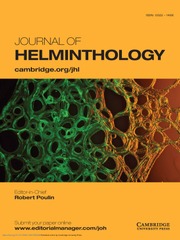No CrossRef data available.
Article contents
Is the risk of bank vole infection with cestodes related to the population dynamics regime?
Published online by Cambridge University Press: 20 January 2025
Abstract
The bank vole (Clethrionomys glareolus (Schreber, 1780)) is the dominant species in the primary fir-spruce forests of the Visim State Biosphere Reserve in the Middle Urals. Here, we studied the long-term population dynamics of small mammals and infection rates with cestode larvae (Cestoida) of bank voles from 1995 to 2021. In addition to the traditionally studied risk factors of parasite infection (e.g., age and sex, phase of population cycle of the host), we assessed the possible influence of the intermediate host population dynamics by contrasting parts of the time series with regular 3-year cyclicity and noncyclic regime. The overall risk of larval cestode infections was 5.0% (95% CI: 4–6%, Ninfected = 97, Ntotal = 1938). The infection rate was associated with the animals’ age and, unexpectedly, with the intermediate host population dynamics regime. The odds of finding cestode larvae in overwintered individuals were 4.3 times (2.8–6.6) higher than in young of the year, and in the noncyclic regime, the odds were 2.3 times (1.5–3.5) higher than in the 3-year cyclicity regime. No statistically significant higher risk of infection was found for males compared to females as the infection rate was only 1.4 times (0.9–2.1, ≈ 1) higher. The higher infection rates of overwintered individuals were as expected for individuals associated with longer exposure to the invasive parasite stages. We hypothesised that the noncyclic regime in long-term fluctuations of rodent numbers better resonates with the characteristic period of the cestodes’ life cycle, resulting in higher infection rates.
Information
- Type
- Short Communication
- Information
- Copyright
- © The Author(s), 2025. Published by Cambridge University Press

